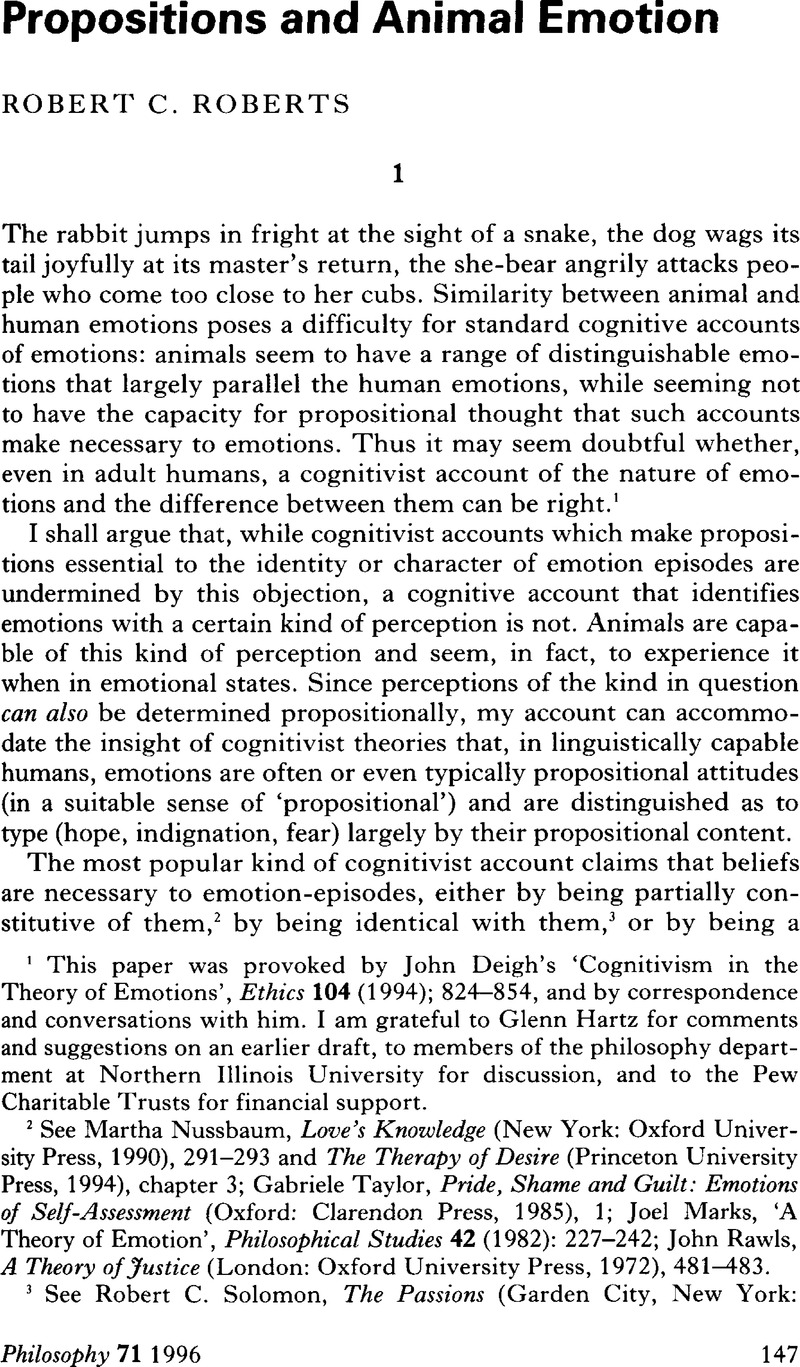Article contents
Propositions and Animal Emotion
Published online by Cambridge University Press: 30 January 2009
Abstract

- Type
- Discussion
- Information
- Copyright
- Copyright © The Royal Institute of Philosophy 1996
References
1 This paper was provoked by John, Deigh's ‘Cognitivism in the Theory of Emotions’, Ethics 104 (1994); 824–854, and by correspondence and conversations with him. I am grateful to Glenn Hartz for comments and suggestions on an earlier draft, to members of the philosophy department at Northern Illinois University for discussion, and to the Pew Charitable Trusts for financial support.Google Scholar
2 See Martha, Nussbaum, Love's Knowledge (New York: Oxford University Press, 1990), 291-293Google Scholar and The Therapy of Desire (Princeton University Press, 1994), chapter 3;Google ScholarGabriele, Taylor, Pride, Shame and Guilt: Emotions of Self-Assessment (Oxford: Clarendon Press, 1985), 1;Google ScholarJoel, Marks, ‘A Theory of Emotion’, Philosophical Studies 42 (1982): 227–242;Google ScholarJohn, Rawls, A Theory of Justice (London: Oxford University Press, 1972), 481–483.Google Scholar
3 See Solomon, Robert C., The Passions (Garden City, New York: Doubleday, 1977), 185–187,Google Scholar and the view of Chrysippus as expounded by Martha, Nussbaum in The Therapy of Desire, especially chapters 9 and 10. In chapter 10 Nussbaum defends and presumably accepts Chrysippus' claim that emotions are identical with evaluative judgments ofa certain kind.Google Scholar
4 See Donald, Davidson, ‘Hume's Cognitive Theory of Pride’ in Essays on Actions and Events (Oxford University Press, 1980), 284;Google ScholarGordon, Robert M., The Structure of Emotions (Cambridge University Press, 1987), ix, 49–52.Google Scholar
5 On Greenspan's view an emotion is an array of evaluative propositions or thoughts held in place by comfortable or uncomfortable affects which take the propositions as their intentional objects. See her Emotions and Reasons (London: Routledge and Kegan Paul, 1988), 3–9.Google Scholar
6 ‘What An Emotion Is: A Sketch’ Philosophical Review 97(1988), 183–209.CrossRefGoogle Scholar
7 Paul Churchland defends what he calls ‘sensational plasticity’—the variability of sensory experience with whatI call its ‘terms’. Thus sensory experience is not just ‘straight’ sensation plus an interpretation, but the terms of sensory construal affect the quality of the sensory experience itself. See A Neurocomputational Perspective: The Nature of Mind and the Structure of Science (Cambridge: MIT Press, 1989), especially the examples on p. 260. Since human emotions, on my account, are construals but not necessarily sensory, I shall affirm not just sensory, but experiential plasticity.Google Scholar
8 We don't typically infer people's mental states from their facial and other behavioral expressions; we perceive them in such expressions.Google Scholar
9 I owe this observation to Harold I. Brown.
10 This sentence expresses the concern on which the emotion is based. Thus while some propositions are about states of affairs ‘simply’ (so to speak), others, like this one, are about the valueor import of states of affairs. It is arguable, and phenomenologically it is often the case, that the value or import of a state of affairs is just another of its facets, not less ‘objective’ than its other facets. As in the case of the other facets, there are subjective qualifications for perceiving it and there may be more or less interminable disagreement about it.
11 Anxiety shades into fear, and the dimension of the shading is the definiteness of the certainty of the threat. If the harm is very well defined and/or is construed as quite likely to occur, we have fear; if it is less well defined and/or construed as fairly remote, we have anxiety.
12 Of course the fear of pain may not be her only fear, so rid of this fear she may still be afraid.
- 13
- Cited by




